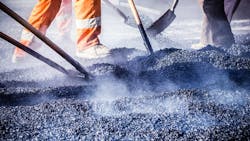OSHA provides contractors and workers with asphalt paving guidance in many areas but falls short when it comes to worker personal breathing zones (PBZ) and asphalt fumes. Despite acknowledging that asphalt fumes carry carcinogens, no specific national OSHA standards for asphalt fumes exposure exist. Instead, OSHA defaults to 29 OSHA-approved state plans. State plans are OSHA-approved workplace safety and health programs operated by individual states or U.S. territories. Twenty-two state plans cover private sector, state, and local government workers, and seven other state plans cover only state and local government workers.
What little guidance is available on how long one can breathe asphalt fumes safely varies. Permissible exposure limits (PEL) include a 30-year-old proposed (not passed) exposure limit put forward by OSHA limiting fumes to 5 mg/m3 (milligrams of a chemical in a cubic meter of air) during an 8-hour work shift. NIOSH currently says no more than 5 mg/ m3 maximum exposure per 15 minutes. Other experts suggest no more than 0.5 mg/m3 exposure.
Read also: How to Keep Asphalt Paving Safe
Hot asphalt can emit hydrogen sulfide gas, which can cause lung irritation, suffocation, or death. The most common effects of short-term inhalation include throat and eye irritation, nasal and lung irritation, dizziness, and fatigue. Long-term inhalation of certain asphalt mixes can lead to liver, kidney, emphysema, and nervous system damage. Asphalt additives can have their own PEL limits, and asphalt equipment cleaning procedures using diesel fuel to pull off hot mix asphalt can carry additional risk. If possible, use a cleaner made specifically for paving equipment.
To lessen the effects of inhaled asphalt fumes, workers should wear a properly fit-tested full-face respirator that uses vapor cartridges. Medical style N95 masks do not screen out hot-mix asphalt’s carcinogenic gas vapors.
